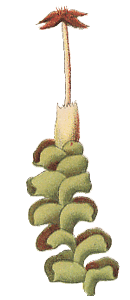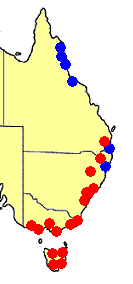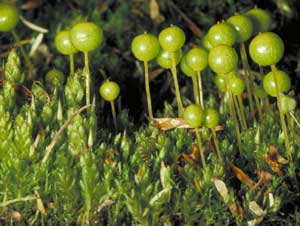
Bryogeography
Bryogeography at different levels
 You can look at bryophyte distributions at various taxonomic levels and it is useful to do so. We'll use some mosses as examples and start by looking at the species level. You've already met the cosmopolitan Bryum argenteum. At the other extreme is Tayloria gunnii
You can look at bryophyte distributions at various taxonomic levels and it is useful to do so. We'll use some mosses as examples and start by looking at the species level. You've already met the cosmopolitan Bryum argenteum. At the other extreme is Tayloria gunnii ![]() , found only in Tasmania. For something in between consider the mosses Lopidium concinnum and Lopidium struthiopteris. The accompanying map shows their Australian distributions: Lopidium concinnum (red dots) and Lopidium struthiopteris (black dots). Outside Australia Lopidium concinnum occurs in New Zealand, Chile, Bolivia and Brazil and Lopidium struthiopteris is found in Africa, south India, Sri Lanka, many areas of South-East Asia, southern China, Japan, Melanesia and Polynesia. The only place where the ranges of the two mosses overlap is in Australia in a small area near the Queensland/New South Wales border.
, found only in Tasmania. For something in between consider the mosses Lopidium concinnum and Lopidium struthiopteris. The accompanying map shows their Australian distributions: Lopidium concinnum (red dots) and Lopidium struthiopteris (black dots). Outside Australia Lopidium concinnum occurs in New Zealand, Chile, Bolivia and Brazil and Lopidium struthiopteris is found in Africa, south India, Sri Lanka, many areas of South-East Asia, southern China, Japan, Melanesia and Polynesia. The only place where the ranges of the two mosses overlap is in Australia in a small area near the Queensland/New South Wales border.
Going up a step to genera you'll also see that some are widespread while others have a limited range. While the species Tayloria gunnii is restricted to TasmaniaTayloria, as a genus, is cosmopolitan since it is found on all continents except Antarctica. The genus has 40 species but none of them has a range anywhere near as wide as that of Bryum argenteum. Some have been found only in relatively small areas, and you've already seen an extreme example of this with Tayloria gunnii, while others are found over a considerable range. We'll look at a few examples of the latter. Within the Southern Hemisphere Tayloria there are about a dozen circum-Pacific species that are largely confined to the Australasian and South American areas, with just the odd species or two also found on some of the sub-Antarctic islands associated with Australasia or South America. Within this group none of the Australasian species are found in South America and none of the South American species are found in Australasia. Looking at the Northern Hemisphere we find that Tayloria lingulata is found in North America and many parts of northern Eurasia, from Europe through to north-eastern China. Then there is Tayloria rudolphiana, which has an odd distribution, being found in Europe (in limited areas of Austria, Germany and Switzerland) and in south-western China (in Yunnan and Hunan provinces). Both Tayloria lingulata and Tayloria rudolphiana are Holarctic species but whereas the first is a "whole of the Holarctic" species the second has a strange, disjunctive distribution within the Holarctic Kingdom. Disjunctive bryophytes are those found in widely separated areas but not in the intervening areas![]() .
.
The genus Lopidium contains just two species and, as you saw above, is largely a genus of the Holantarctic and Paleotropic Kingdoms. The genus Pleurophascum contains three species, two confined to southern Australia (in Western Australia and Tasmania) with the third restricted to South Island of New Zealand. Therefore it is a strictly Holantarctic genus. More to the point it's restricted to the Australasian region of the Holantarctic![]() .
.
The next step up the classification hierarchy is family. Just as a genus typically includes a number of related species, so a family typically includes a number of related genera. A very unusual species may be the only member in a genus and similarly an unusual genus may be the only member in a family. There's more about these topics under CLASSIFICATION. The family Hypopterygiaceae contains Lopidium and seven other genera: Arbusculohypopterygium, Canalohypopterygium, Catharomnion, Cyathophorum, Dendrocyathophorum, Dendrohypopterygium and Hypopterygium. In total there are 21 species in the family. All these genera are found in the Southern Hemisphere and four are also found in the northern hemisphere, mainly in Central Africa or South-East Asia. Of the seven, only Hypopterygium is found in the northern hemisphere Americas. Pleurophascum is the only genus in the family Pleurophascaceae. For the purposes of illustrating the variety of distribution patterns and the methods of bryogeographical reasoning, species and genus will generally suffice in this introductory website.
![An Australian Government Initiative [logo]](/images/austgovt_brown_90px.gif)


